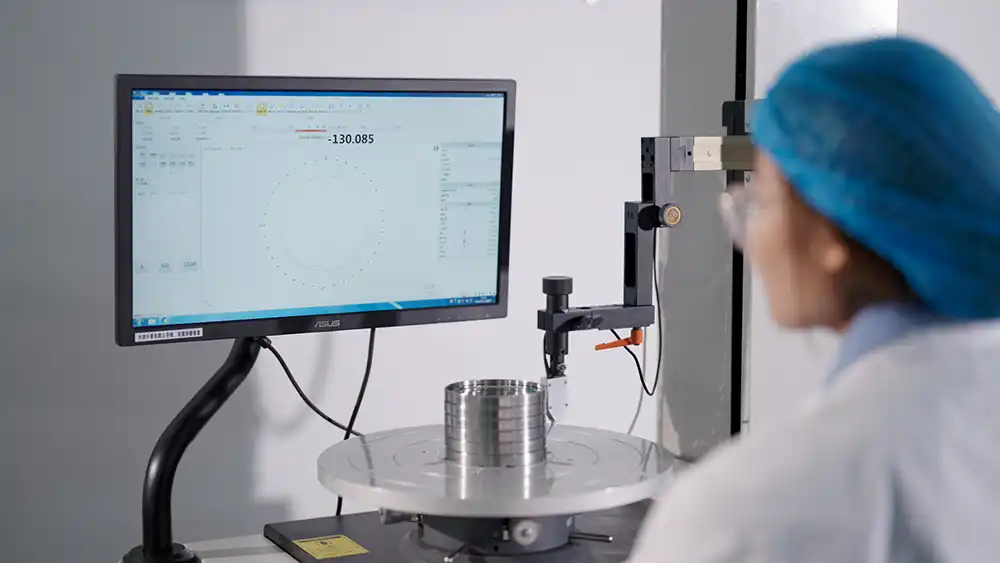What are the Load Ratings for Metric Thin Section Bearings?
Metric thin section bearings represent a critical advancement in precision engineering, offering an optimal balance between compact design and load-bearing capability. These specialized components are distinguished by their characteristic thin cross-section, typically maintaining a constant section height across all bore diameters within a series. While traditional bearings often require substantial space allocation, thin section bearings deliver comparable performance in a fraction of the space, making them invaluable in modern engineering applications where space optimization is paramount.

How do you calculate the load capacity of thin section bearings?
Metric thin section bearings represent a specialized category of precision bearings that require particularly careful consideration when calculating load capacities due to their unique dimensional characteristics. The reduced cross-sectional profile, while offering significant space and weight advantages, necessitates especially precise load capacity calculations to ensure reliable operation and optimal service life.
The fundamental approach to calculating load capacity for metric thin section bearings begins with the static load rating (C0), which is crucial for applications where the bearing experiences stationary or very slow-motion loads. This calculation must account for the bearing's distinctive geometric properties, particularly the reduced cross-sectional profile that characterizes thin section bearings. The dynamic load rating (C) calculation becomes even more critical due to the unique challenges posed by the minimal material cross-section.

For metric thin section bearings, the basic dynamic load rating formula remains C = bm fc (i cos α)0.7 Z2/3 D1.8, but the interpretation and application of these factors require special consideration. The rating factor bm must be carefully adjusted to account for the reduced cross-section's impact on overall bearing strength. The manufacturing quality factor fc becomes particularly crucial due to the tighter tolerances required for thin section bearings, as even minor deviations can significantly affect performance.
When engineering applications using metric thin section bearings, several critical factors require special attention. The operating environment's impact becomes more pronounced due to the reduced thermal mass of thin section bearings, potentially affecting internal clearances and preload conditions. The mounting arrangement demands exceptional precision, as thin section bearings are more sensitive to misalignment due to their reduced cross-section. Additionally, lubrication systems must be carefully designed to ensure adequate film formation while considering the unique geometry of thin section bearings.
Material selection plays a vital role in thin section bearing performance, with high-grade bearing steels being essential to maintain adequate load capacity despite the reduced material volume. The heat treatment and surface finishing processes must be precisely controlled to achieve optimal hardness and surface characteristics while maintaining dimensional stability. These factors directly influence the bearing's ability to handle both static and dynamic loads effectively.

Speed considerations become particularly critical with thin section bearings, as their reduced mass can affect dynamic behavior at higher speeds. The calculation of speed ratings must account for both the mechanical limitations imposed by the thin cross-section and the thermal management capabilities of the bearing system. This often requires detailed analysis of heat generation and dissipation characteristics specific to thin section designs.
Modern engineering practices for metric thin section bearings increasingly rely on finite element analysis and computational modeling to predict load capacity and behavior under various operating conditions. These advanced analytical tools help optimize bearing designs and selection while accounting for the complex interplay of geometric, material, and operational factors that influence load capacity. This comprehensive approach ensures reliable performance while maximizing the advantages offered by thin section bearings' space-saving characteristics.
What factors affect the performance of thin section bearings?
The performance of metric thin section bearings is influenced by a complex interplay of various factors that must be carefully considered during design and application. Temperature plays a crucial role in these precision components, with most metric thin section bearings designed to operate effectively within a temperature range of -20°C to +120°C. The thermal characteristics are particularly critical given their thin cross-section, which makes them more sensitive to thermal expansion and contraction effects. These thermal variations can significantly impact the bearing's internal clearances and operational efficiency.
Mounting considerations are especially critical for metric thin section bearings due to their unique design characteristics. The reduced cross-sectional profile that makes these bearings advantageous in space-constrained applications also makes them particularly sensitive to mounting conditions. Precise alignment is absolutely essential, as even minor misalignment can lead to premature failure due to uneven load distribution. The housing and shaft fits must be specified with extreme precision, taking into account the bearing's thin-walled construction and its impact on mounting tolerances.
Speed and rotational factors present unique challenges in metric thin section bearing applications. Their lightweight design and reduced cross-section allow for higher speeds compared to conventional bearings of similar diameter, but this advantage must be carefully balanced against the increased sensitivity to centrifugal forces. As operating speeds increase, heat generation becomes a critical consideration, necessitating careful attention to lubrication systems and cooling strategies. The cage design must be optimized to ensure stable operation at high speeds while maintaining proper lubricant distribution.
Environmental considerations take on heightened importance with metric thin section bearings due to their relatively delicate construction. Protection against contamination is crucial, as even small particles can cause significant damage given the precise clearances involved. Humidity and moisture exposure must be carefully managed through appropriate sealing solutions, while maintaining the bearing's characteristic low-friction performance. In specialized applications, such as aerospace or clean room environments, additional environmental factors like atmospheric pressure variations or cleanliness requirements must be addressed through specific design features and material selections.
Material selection for metric thin section bearings requires careful consideration of the application's demands. While high-grade chrome steel remains a common choice for standard applications, specialized materials such as stainless steel or ceramic components may be necessary for more demanding environments. Surface treatments and coatings can significantly enhance performance characteristics, particularly in applications requiring improved wear resistance or corrosion protection. The thin cross-section makes material quality even more critical, as any material inconsistencies can have a proportionally larger impact on bearing performance and reliability.
These various factors are interconnected and must be considered holistically when designing and implementing metric thin section bearing solutions. The successful application of these bearings requires careful attention to all these aspects, along with proper installation procedures and ongoing maintenance protocols to ensure optimal performance throughout their service life. The specific requirements of each application must be carefully evaluated to achieve the right balance between these various factors while maintaining the space-saving advantages that make metric thin section bearings such valuable components in modern machinery design.
What are the typical applications for thin section bearing series?
Metric Thin Section Bearings have emerged as crucial components across diverse industrial applications, particularly where space optimization and precise rotational movement are paramount. In the robotics and automation sector, these bearings excel in robot arm joints and precision positioning systems, enabling smooth articulation and accurate movement in automated assembly lines and pick-and-place operations. The medical equipment industry heavily relies on these bearings for critical applications such as CT scanner gantries and surgical robots, where their compact design and precise rotation capabilities are essential for achieving optimal performance in space-constrained environments.
In aerospace applications, metric thin section bearings play a vital role in aircraft control surface actuators and satellite deployment mechanisms, where their lightweight yet robust construction provides reliable performance in extreme conditions. The semiconductor manufacturing industry utilizes these bearings in clean room environments for wafer handling equipment and precision stages, benefiting from their ability to operate smoothly while maintaining strict cleanliness standards. Defense applications such as radar systems and optical tracking devices leverage these bearings for their precision positioning capabilities and durability under demanding operational conditions.
The selection and implementation of metric thin section bearings requires careful consideration of various factors including load patterns, operating speeds, and environmental conditions. Engineers must evaluate precision requirements, service life expectations, and space constraints while ensuring cost-effectiveness and maintainability. These bearings must often meet stringent tolerance specifications while operating reliably in diverse environments, from sterile medical facilities to harsh aerospace conditions. Their design allows for optimal performance in applications where traditional bearings would be too bulky or inadequate, making them indispensable in modern precision engineering applications.
In all these applications, metric thin section bearings offer advantages such as reduced weight, minimal space requirements, and high precision movement, while maintaining the necessary load-bearing capabilities. Their specialized design enables them to handle both radial and axial loads effectively, despite their compact profile, making them ideal for applications where space is at a premium but performance cannot be compromised. The continued advancement in bearing materials and manufacturing techniques has further enhanced their capabilities, allowing for even more demanding applications in various high-tech industries.

Luoyang Huigong Bearing Technology Co., Ltd. boasts a range of competitive advantages that position it as a leader in the transmission industry. Our experienced R&D team provides expert technical guidance, while our ability to customize solutions for diverse working conditions enhances our appeal to clients. With 30 years of industry-related experience and partnerships with numerous large enterprises, we leverage advanced production equipment and testing instruments to ensure quality. Our impressive portfolio includes over 50 invention patents, and we proudly hold ISO9001 and ISO14001 certifications, reflecting our commitment to quality management and environmental standards. Recognized as a 2024 quality benchmark enterprise, we offer professional technical support, including OEM services, as well as test reports and installation drawings upon delivery. Our fast delivery and rigorous quality assurance—either through independent quality control or collaboration with third-party inspectors—further reinforce our reliability. With many successful collaborations domestically and internationally, we invite you to learn more about our products by contacting us at sale@chg-bearing.com or calling our hotline at +86-0379-65793878.
References:
1. SKF Bearing Technical Manual (2021) - "Load Ratings and Bearing Life Calculations"
2. NSK Technical Report (2023) - "Thin Section Bearing Design and Applications"
3. Kaydon Bearing Technical Guide (2022) - "Engineering Data for Thin Section Bearings"
4. INA/FAG Catalog (2023) - "Precision Bearings for Special Applications"
5. JTEKT Engineering Journal (2022) - "Advanced Bearing Technology"
6. NTN Technical Review (2023) - "Thin Section Bearing Development"
7. American Bearing Manufacturers Association (2022) - "Load Rating Standards"
8. ISO 281:2007 - "Rolling bearings - Dynamic load ratings and rating life"
9. Machine Design Magazine (2023) - "Selecting Thin Section Bearings"
10. Timken Engineering Manual (2023) - "Thin Section Bearing Applications Guide"

